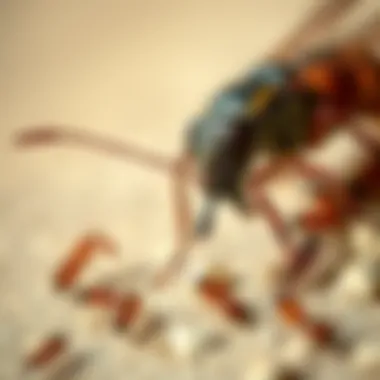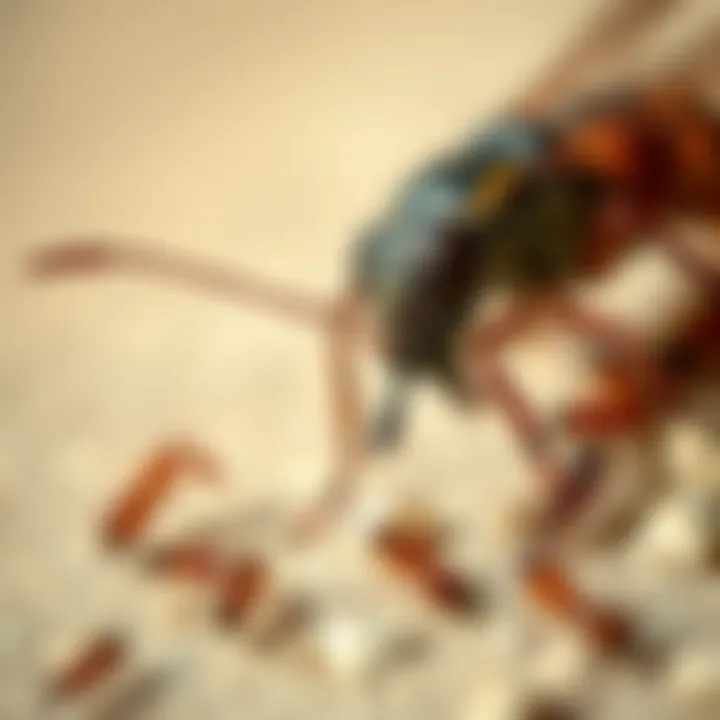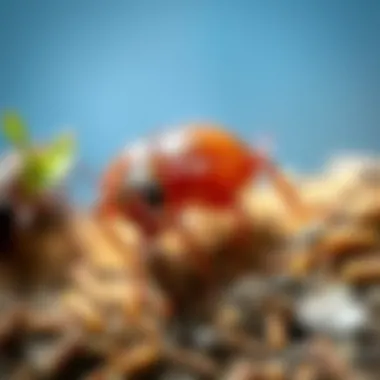Safe Pest and Termite Control: A Comprehensive Guide


Intro
In the realm of maintaining a home, pest control often sits at the back of the line when it comes to priorities. However, a home infested with pests can lead to numerous issues, from health concerns to structural damage. This guide aims to shed light on the crucial role of safe pest and termite control, focusing on methods that prioritize the environment alongside your comfort.
Pests are not just a nuisance; they can compromise the quality of life for those living in your abode and can wreak havoc on the very structure that gives you shelter. Effective pest management extends beyond just eradication–it involves understanding what pests are present, how they thrive, and what proactive measures can be taken to discourage their unwanted intrusion.
The right methods for pest control not only ensure you have a pest-free environment but also maintain the safety of people, pets, and the planet. As we delve into pest identification, prevention strategies, and treatment options, we’ll uncover insights that empower every homeowner and concerned individual to make informed decisions. Remember, a well-informed approach is your best weapon in safeguarding your home and loved ones.
Pest Identification
Identifying pests accurately is a critical first step in combating infestations. Various species of pests exhibit unique characteristics and behaviors, and knowing these can lead you to the right treatment.
Detailed descriptions of common pests
Among the usual suspects are:
- Ants: These little critters can be seen marching in a line. Carpenter ants are particularly troublesome as they hollow out wood, causing structural damage.
- Roaches: Dark and slippery, these pests tend to appear in the evenings. American and German roaches are among the most common, often found in kitchens and bathrooms.
- Termites: Termites are silent destroyers. Swarmers are often seen in spring, and mud tubes may indicate their presence.
- Rodents: Mice and rats can bring a host of diseases. Look for gnaw marks or, worse, droppings in the corners of rooms.
Signs and symptoms of infestations
The signs of infestations may be subtle, so here’s what to watch for:
- Visible Droppings: Each pest has its unique droppings. Regular inspections can help catch this early on.
- Hollow Sounds: If you hear tapping sounds from walls, this could indicate a termite presence.
- Unusual Smells: Some pests, especially rodents, produce a distinct odor that can be noticeable.
Understanding these characteristics helps not only in confirming an infestation but also guides the prevention and treatment strategies that follow.
Prevention Strategies
Preventing pests from becoming a problem is easier than dealing with an infestation. A proactive approach is key.
Home maintenance tips for pest prevention
- Sealing Cracks: Use caulk to seal any openings. This can help block entry points for pests.
- Proper Storage: Store food in airtight containers. Dispose of garbage regularly to remove any potential food source.
- Maintaining Gutters: Clean gutters regularly to avoid stagnant water, which attracts pests.
Natural deterrents and barriers
Several natural substances can keep unwanted guests at bay:
- Essential Oils: Peppermint and eucalyptus oils are said to repel ants. A few drops can go a long way.
- Diatomaceous Earth: This powdery substance can be sprinkled in areas where insects are seen. It causes dehydration in pests that come in contact with it.
Treatment Options
If prevention fails and pests invade, it’s essential to know the options available for treatment.
Overview of chemical vs. natural treatments
- Chemical Treatments: While effective, many chemical solutions can be harmful to humans and pets. Always read labels and follow instructions carefully.
- Natural Treatments: Options like vinegar and baking soda can be used for minor infestations and are generally safe to use around the home.
Step-by-step guides for DIY treatments
- Ants in Your Kitchen: Mix a solution of water and vinegar, spray the area, and wipe clean to remove pheromone trails that attract more ants.
- Dealing with Roaches: Combine baking soda with sugar and place it where you’ve seen them. The sugar lures them in, and the baking soda kills them.
Turning to nature can reduce reliance on harsh chemicals while still providing effective results.
To conclude, safe pest management is not merely a luxury but a necessity for a healthy home. Understanding your enemy, preventing opportunities for intrusion, and having treatments ready can help create an environment where pests don’t stand a chance. Armed with the right knowledge, you can protect your home without compromising your health or that of the planet.
Prologue to Pest Management
Pest management is essential for maintaining a comfortable, healthy living environment. Understanding how to effectively manage pests is not just about getting rid of unwanted guests, it involves creating a balanced approach to keep one’s home safe and sound. What does that mean for homeowners? Essentially, it guides them in preventing, identifying, and treating infestations with a thoughtful strategy that prioritizes safety and environmental factors.
Understanding Pests and Their Threats
Pests can present various threats, from health concerns to property damage. Common household pests like ants, rodents, and termites aren’t just an eyesore. They can affect the quality of your home life and pose severe risks to both physical well-being and structural integrity. For instance, termites can undermine the very foundation of a house, resulting in costly repairs if left unchecked. In addition to these structural issues, pests can carry diseases that pose health risks especially to children and pets.
Understanding specific pests and their behaviors is critical to developing targeted control strategies. Take, for instance, bed bugs. These tiny insects bite and cause discomfort, leading to sleepless nights when they invade a home. Knowledge is power, knowing what attracts pests, or the conditions they thrive in helps in managing them effectively.


The Importance of Safe Practices
Turning to safe practices is not merely a trend; it's a necessity in today’s world where health and sustainability interlink more than ever. Chemical pest control methods may provide quick fixes, but they often carry potential risks to human health and the environment. Using safer alternatives not only mitigates the risk of harmful exposures but also helps in fostering a healthier atmosphere at home.
Homeowners are increasingly gravitating towards eco-friendlier methods that minimize harm. Utilizing natural deterrents or integrated pest management techniques fosters an attitude of responsibility towards the surrounding environment. Moreover, these practices often extend beyond just pest control — they can contribute to long-term health benefits for everyone in the household, leading to a genuine sense of peace of mind.
"An ounce of prevention is worth a pound of cure."
Emphasizing safe pest management practices leads to effective, responsible decisions. The move towards safer methods of pest control represents a significant step in protecting our homes and reinforcing our commitment to both our families and the environment.
Identifying Common Pests
Understanding how to identify common pests is foundational in the realm of pest management. Distinguishing between various species not only aids homeowners in effectively mitigating infestations but also enables them to adopt the right preventative measures before a small problem escalates into a significant one. This section will delve into the characteristics of pests, particularly termites and other household nuisances, highlighting their distinctive traits and behaviors.
Recognizing Termites
Termites, often dubbed the "silent destroyers," can inflict significant damage to wooden structures if left unchecked. Knowing how to recognize them is crucial. These small insects can be mistaken for ants, but several features set them apart. For instance, termites have a straight waist and long, straight antennae—contrasting sharply with ants, which have a pinched waist and bent antennae.
Furthermore, droppings that resemble sawdust or wood shavings near wooden structures can be a significant indicator of termite presence. Their mud tubes, often found along walls, serve as highways for these pests and are warning signs that should not be ignored. Early detection can prevent extensive damage and save substantial repair costs.
Spotting Other Household Pests
Ants
Ants are ubiquitous and often invade homes in search of food and shelter. Their ability to create large colonies allows them to appear seemingly out of nowhere. One key characteristic is the pheromone trails they leave behind, which others follow to food sources. While many ants, like the common black ant, tend to be harmless, others can pose health risks, carrying bacteria between outdoor surfaces and your kitchen. Addressing an ant problem early can help sidestep a potential infestation.
Rodents
Rodents, especially mice and rats, are another common household pest. Their presence can often be detected through gnaw marks on furniture, walls, or food packages. They reproduce rapidly, meaning that a few individuals can swiftly transform into a serious problem. Their key characteristic includes long tails and large front teeth, which they constantly need to gnaw down through daily wear. Beyond the threats of damage, rodents can also be carriers of diseases, making it imperative to address their presence promptly.
Spiders
Spiders can be a mixed bag in households. While many are harmless and even beneficial by preying on pests, others can deliver a painful bite. One distinctive feature of spiders is their eight legs and the presence of webs, which they use to trap prey. Homeowners should be cautious with certain varieties, such as black widows or brown recluses, which can pose health risks, particularly to children and pets. Regular checks in corners, basements, and attics can monitor and help manage spider populations effectively.
"An ounce of prevention is worth a pound of cure."
Understanding your pests can make all the difference.
For further reading on pest identification, you might consider visiting U.S. Environmental Protection Agency or National Pesticide Information Retrieval System.
Safe Prevention Strategies
Safe prevention strategies are the backbone of any effective pest management approach. This aspect not only aims to keep unwanted guests at bay but does so without compromising the health of your household or the environment. Taking these proactive measures ensures you're not just reacting to pest problems, but rather preventing them from taking root in the first place. With a bit of foresight and diligence, homeowners can avoid the hassle and costs that come with pest infestations.
Home Maintenance Approaches
Sealing Entry Points
Sealing entry points is like putting up a fence around your garden. It stops pests from wandering in uninvited. One key characteristic of sealing entry points is that it creates a physical barrier against invasive species. Cracks in walls, gaps around windows, or crevices found in door frames can serve as welcome mats for pests. By identifying and sealing these openings, you significantly reduce the chances of infestations. This method’s popularity stems from its effectiveness and simplicity. It’s a beneficial choice for any household that values being proactive rather than reactive.
The unique feature of sealing entry points is that not only does it keep pests out, but it can also improve your home's energy efficiency by preventing drafts. However, while this approach has many advantages, it does require ongoing inspection and maintenance to ensure that the seals remain intact as wear and tear occurs over time.
Regular Inspections
Regular inspections function as an early warning system for potential pest issues. This practice consists of checking your home periodically for signs of pest activity, such as droppings, nests, or damage to structures. Its key characteristic lies in the ability to catch problems before they escalate, making it a popular and effective choice for household pest management.
A distinct aspect of regular inspections is the peace of mind it provides; knowing that you are taking steps to prevent an infestation can alleviate stress for many homeowners. It acts as a preventive measure that complements other strategies like sealing entry points. On the flip side, one disadvantage could be the time commitment it requires. However, the benefits far outweigh the drawbacks when considering the protection it offers your home.
Natural Deterrents and Repellents
Natural deterrents and repellents have grown in popularity for their role in creating a pest-free environment without relying on chemical treatments. They allow homeowners to embrace eco-friendliness while still effectively combating pests.
Essential Oils
Essential oils offer a natural way to ward off pests in your home. The specific aspect that makes them valuable in pest management is their strong odors. Oils like peppermint, lavender, and tea tree can effectively repel various insects. This has made them a beloved choice among those who prefer organic solutions. Their unique feature lies in how versatile they are. You can use them in diffusers, sprays, or even add them to cleaning products. However, it's essential to recognize that while essential oils can deter pests, they may not eliminate infestations entirely, which could necessitate supplementary methods for serious pest problems.
Vinegar and Baking Soda
Vinegar and baking soda are kitchen staples that double as powerful pest control agents. The specific aspect of vinegar is its strong acidity, rendering it effective for cleaning and repelling certain pests like ants. Baking soda, on the other hand, when mixed with sugar, can become a bait that lures and kills pests. These items are a popular choice due to their accessibility and low cost.


A unique feature of vinegar and baking soda is their safety in households with children and pets. They generally pose fewer health risks compared to some commercial pesticides. However, while they are effective as preventive measures, their efficacy may vary depending on the severity of the pest problem. It's crucial for homeowners to combine these methods with other strategies for optimal results.
"Taking preventative measures is like tightening the bolts before the storm. It keeps your household secure and sound."
In summary, these safe prevention strategies form the foundation for effective pest and termite control. From home maintenance practices to natural deterrents, each approach plays a critical role in safeguarding your living space against invasions.
Effective Treatment Options
In pest management, determining the right treatment options is like finding the right key to unlock a door. Choosing effective treatment methods is essential, as these direct approaches help homeowners tackle infestations promptly and efficiently. A well-informed selection can influence the overall health of your environment and safeguard your living space against future threats. As we delve into effective treatment options, we’ll explore both chemical treatments and biological control measures, highlighting what makes each viable and cornerstones for an integrated approach.
Chemical Treatments
Chemical remedies are frequently employed in pest control due to their efficacy in delivering quick results. They are particularly useful in scenarios where immediate action is required to eradicate burgeoning infestations. However, wading through the types of chemicals available necessitates a nuanced understanding of their properties and implications.
Types of Chemicals
When it comes to types of chemicals, several categories come into play. Insecticides, fungicides, and herbicides are commonly deployed depending on the nature of the pest problem. Insecticides, for example, are effective against a multitude of pests, including termites and ants. The primary appeal of insecticides lies in their ability to produce tangible results within hours of application.
A key characteristic of many insecticides is their selective toxicity; they target specific pests while aiming to minimize harm to beneficial organisms, such as pollinators. Yet, it’s essential to acknowledge that not all insecticides conform to this standard. Some chemical options can pose risks to humans, pets, and wildlife. Consequently, it is crucial to assess the unique situation and to weigh the potential advantages and disadvantages before deciding on the specific type of chemical to use.
Safety Precautions
In tandem with the usage of chemical treatments, safety precautions must be taken seriously. These precautions act as a buffer to mitigate risks associated with chemical exposure. Proper personal protective equipment, such as gloves and masks, is a vital staple to safeguard one’s health during application.
Key characteristics of safety precautions include understanding the label instructions and maintaining ventilation during application. It's often lauded as a beneficial practice not only for health reasons but also to ensure effective chemical performance. Notably, implementing safety measures can encourage responsible usage of chemicals and prevent unfortunate incidents from occurring.
Biological Control Measures
Biological control measures represent an eco-friendlier avenue for pest management, meticulously relying on natural solutions. Harnessing nature’s own defenses might be less immediate in effect compared to chemical treatments, but the long-term benefits are indisputable. Shifting towards biological options often leads to a more balanced ecosystem within your home and community.
Beneficial Nematodes
Beneficial nematodes, microscopic worms that hunt down pests like grubs and larvae, serve as a prime example of biological control methods. They function by entering pests and releasing bacteria that ultimately lead to the host's demise. This natural solution is not just operational but is particularly appealing due to its minimal impact on the surrounding environment.
Their standout feature is their ability to persist in the soil, providing an ongoing defense against pest resurgence. They are undoubtedly a popular choice among gardeners and homeowners looking for organic solutions to pest control. However, careful application is key; conditions must be ideal for nematodes to thrive and effectively control pest populations.
Predatory Insects
Another facet of biological control involves employing predatory insects such as ladybugs and lacewings. These naturally occurring beneficial insects thrive on other pests, resembling nature’s very own pest control team. Their compelling characteristic lies in their natural habits; they hunt and feed on harmful pests like aphids, thus drastically reducing their numbers without introducing harsh chemicals to the environment.
The advantages are clear: reduced reliance on synthetic pesticides and an enhancement of biodiversity within home gardens or landscapes. However, their availability can be somewhat seasonal, which might limit their effectiveness in certain situations. Thus, timing and monitoring are essential to ensure the best outcomes.
Ultimately, understanding these treatment options allows homeowners not only to combat present pest infestations but also to lay down a healthier foundation for future pest management. By weighing the pros and cons, individuals can make informed decisions that consider both immediate needs and long-term ecological balance.
Integrative Pest Management
Integrative Pest Management (IPM) represents a holistic approach that's steadily gaining momentum in pest control. It intertwines multiple strategies for managing pests in a sustainable way. This method pays dividends by reducing reliance on harmful chemicals, promoting environmental balance, and ensuring public health.*
The beauty of IPM lies in its adaptability. This method includes understanding the pest lifecycle, monitoring pest populations, and implementing techniques that work harmoniously instead of one-size-fits-all solutions. By combining cultural, biological, and chemical strategies, you amplify your effectiveness against pests while minimizing any negative side effects.
Combining Methods for Effectiveness
An effective IPM program utilizes a cocktail of methods tailored to specific pests and environments. For instance, when combating termites, a combination of physical barriers and biological controls can yield superior results. For instance:
- Physical Barriers: Installing stainless steel mesh around foundations can prevent termite entry, while keeping wood dry avoids creating a hospitable environment.
- Biological Controls: Introducing beneficial nematodes can help keep pest populations in check without resorting to synthetic pesticides.
Adopting this multi-pronged approach is like cooking with spices. Each ingredient adds a unique flavor, creating a more balanced dish. Therefore, understanding the strengths of various methods is key to crafting an ongoing pest management strategy that evolves over time, adapting to both pest behavior and environmental changes.
Monitoring and Evaluation Strategies
To keep the IPM cycle running smoothly, diligent monitoring and evaluation are paramount. Leaders in pest control emphasize that regular assessment helps in identifying new problems early on, which can save time, effort, and money in the long run. Here’s how to effectively monitor and evaluate pest situations:
- Regular Inspections: Conduct routine checks to identify early signs of infestation. This can include checking baseboards, attics, and storage spaces for activity or damage.
- Pest Traps: Using sticky traps or bait stations can help monitor pest populations effectively, showing not only numbers but also behavior and when infestations occur most often.
- Record Keeping: Document the findings from inspections and traps. Patterns can signal underlying issues, guiding decisions on whether more aggressive interventions are needed.
- Adjusting Treatments: After assessing the effectiveness of current strategies, tweak the approach as necessary, be it by incorporating a new biological agent or reinforcing physical barriers.
"Pest management is not a one-time fix but a journey that requires constant vigilance and adaptation to be truly effective." Throughout this ongoing process, collecting data becomes beneficial, not just for your home but for the larger community. Analyzing trends aids pest control professionals in developing better strategies, ultimately contributing to a healthier environment for everyone.
The integration of these strategies into your pest management routine provides not just a way to control pests but also ensures safety for your family and the environment. In the realm of pest control, adaptation and foresight go hand in hand.


Debunking Pest Control Myths
In the realm of pest and termite management, misconceptions abound like weeds in a garden. Numerous beliefs regarding pest control persist, not just from amateur enthusiasts but even among seasoned homeowners and professionals. Debunking these myths is essential, not only for effective pest management but also for ensuring the safety of families and the environment. Addressing these misconceptions helps to clarify what methods truly work, what to avoid, and enables individuals to make informed choices.
By tackling common beliefs, we facilitate better understanding and adherence to strategies that prioritize safety and efficacy. Knowledge dispels fear, equipping homeowners with the ability to distinguish between genuinely effective pest control methods and those that are unfounded.
Common Misconceptions
There’s a multitude of misunderstandings floating around regarding pests, which can lead to ineffective or even harmful pest control methods. One notable belief is that all insects are harmful and should be eliminated at any cost. This oversimplification often overlooks the role of beneficial bugs. For example, ladybugs and certain wasp species can actually manage aphid populations naturally, fostering healthier gardens without resorting to harsh chemicals.
Another myth is the notion that a clean home is entirely pest-proof. While cleanliness is a factor, pests often find their way indoors not just through dirt, but gaps in structures or small openings. This highlights the importance of building maintenance alongside tidiness.
Here are some other common fallacies about pest control:
- Professional services are always the best option. While they can be effective, not all issues require professional intervention.
- Natural remedies are ineffective. In reality, many natural deterrents can work wonders if applied properly.
- Termites only emerge in the summer. They can cause damage year-round, making vigilance critical.
Clarifying Effective Practices
With misinformation rampant, it’s crucial to differentiate between what’s tried and true in pest control and what’s merely hearsay. First, embrace integrated pest management which combines various strategies tailored to the specific pest issue at hand. This sophisticated approach considers both prevention and treatment in a holistic manner, emphasizing ecological balance.
Moreover, understanding the lifecycle of pests can lead to more effective treatments. For instance, targeting ants during their reproductive cycle can significantly deter populations by breaking the reproductive cycle.
Use of natural barriers such as diatomaceous earth can be quite effective against crawling insects. This fine powder is harmless to humans and pets but deadly to pests. Additionally, regular monitoring of pest populations allows for early intervention and controls before they spiral into bigger issues.
"Knowledge is not power. Knowledge is potential power. Action is power."
Ultimately, staying informed about pest behavior, treatment options, and maintenance practices is key. By embracing effective methods and addressing misconceptions, homeowners and pest control professionals alike can create safer environments, ensuring the well-being of families and communities. This informed approach to pest control not only mitigates infestation risks but also protects our natural surroundings.
Professional Pest Control Services
Pest control isn’t just about waving a magic wand and hoping the problem vanishes. When pests like termites or rodents invade your space, the stakes are high—harming your property and potentially putting your health at risk. Here’s where professional pest control services come into play.
These experts are the cavalry in your battle against bugs and vermin. With their thorough knowledge, they not only respond to infestations but also strategize to prevent them. The importance of engaging a professional can’t be overstated, especially when it comes to certain situations.
When to Seek Help
There comes a time in every homeowner's journey when DIY solutions just don't cut it. While a can of bug spray might work wonders on the occasional ant, here are some instances when it's wise to pick up the phone and call in the pros:
- Severe Infestation: If you’ve found signs of a full-scale invasion, whether it be termite swarms or a mouse family nesting in your attic.
- Health Risks: Some pests, like ticks and rodents, can carry diseases harmful to humans and pets. If you’re facing health risks, quick action is crucial.
- Time Constraints: Between work and family commitments, your schedule might not leave room to make your home pest-proof. Professionals can tackle this efficiently.
- Chronic Problems: If pests keep reappearing despite your best efforts, it may be time to consult a pest control expert.
"Relying solely on DIY methods can lead to more damage and cost in the long run."
Choosing the Right Service Provider
Selecting a dependable pest control service can feel like an overwhelming task, but with a bit of elbow grease, you can find the right fit. Here are factors to consider:
- Licensing and Certification: Ensure that the service provider is licensed to operate in your state. Legitimate companies will have the proper certifications.
- Reputation: Look for reviews on trusted platforms like Yelp or the Better Business Bureau. Word of mouth from neighbors and friends can also point you in the right direction.
- Service Offerings: Not all pests require the same treatment. Whether it’s termites or bedbugs, make sure they have a solid plan for the type you’re dealing with.
- Safety Measures: Ask about their approach to safety. Responsible pest control services should prioritize eco-friendly methods and the health of your family and pets.
- Pricing Transparency: Be wary of hidden fees. A good service should provide upfront pricing and a clear outline of the services they’ll perform.
Picking the right professional pest control service is crucial for ensuring effective and safe treatment. By investing a bit of time in this decision, you are safeguarding your home and peace of mind. Consider it a preventive measure in your ongoing battle against pests.
Culmination and Future Directions
As we wrap up this comprehensive guide on safe pest and termite control, it's clear that the topic holds significant weight for homeowners and caretakers alike. Pest management is not only about eliminating pests but also protecting our environments and loved ones. The strategies we discussed highlight the critical balance between efficacy and safety. Each approach, from understanding pest behavior to implementing eco-friendly solutions, underscores a shared goal: to maintain healthy living spaces free from unwanted guests.
Recap of Key Points
To cement our understanding, let’s revisit the main points covered in this guide:
- Understanding Pests: Recognizing the various threats posed by pests is the first step in management. Identifying species and their behaviors helps in deploying the right control measures.
- Safe Practices: Importance of using safe, environmentally friendly methods rather than relying solely on chemical treatments. Integrating prevention strategies protects health and the environment.
- Prevention and Treatment: Covering methods such as sealing entry points, utilizing natural deterrents, and knowing when to call professionals.
- Debunking Myths: Clarifying misconceptions about pest management to empower informed decision-making.
This recap emphasizes that successful pest control isn’t a one-size-fits-all solution. Instead, it requires a tailored approach that takes into account the specificities of each situation.
The Role of Innovation in Pest Management
Innovation plays a transformative role in how we address pest issues today. New technologies are constantly emerging, offering more efficient, less harmful means to manage pests. For instance, smart traps and apps that identify pest presence via smartphone sensors are the wave of the future. This not only simplifies detection but also allows for targeted responses.
Furthermore, advancements in biological pest control – like the use of entomopathogenic nematodes – prove that nature often holds the key to solving human problems without adverse effects. These innovations pave the way for a more sustainable, health-conscious approach to pest management that aligns with modern sensibilities.
In summary, embracing innovation can enhance our pest control measures while ensuring the safety and well-being of our households. The commitment to safe practices speaks volumes—both for our own homes and the broader community.
As challenges evolve, so must our strategies, paving the way for environmentally conscious solutions well into the future.
"Adapting to new information and technologies is not just an option, but a necessity for effective pest management."
By continually enhancing our practices and understanding the critical role of innovation, we can confidently move forward and create safer environments for all.



